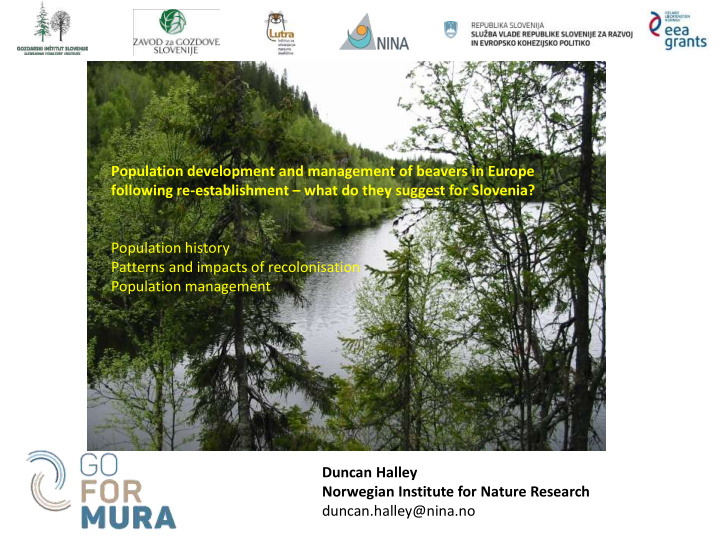



Population development and management of beavers in Europe following re-establishment – what do they suggest for Slovenia? Population history Patterns and impacts of recolonisation Population management Duncan Halley Norwegian Institute for Nature Research duncan.halley@nina.no
Beaver distribution in Europe, 2015 205 documented releases to distinct locations in 23 European countries (outside former Soviet Union) since 1922 IUCN Red Data status: 1920: Endangered C2a (i) (using modern classification) 2002: Near Threatened 2006: Lower risk/near threatened 2008: Least Concern Current minimum world population estimate: 1 073 000
Recolonisation patterns Influence of landforms and hydrology
Sites occupied early strongly associated with: • Riparian deciduous forest • Low stream gradient/many swings in river course • Rich grass and herb layer • Soft soils • Relatively deep water, in which damming is not necessary Typical patterns of spread: Stream gradients over 2% are not Värmland , Sweden normally colonised Habitat requirements otherwise Heavy black lines relax as population development proceeds on a watershed mark watershed Result: most dams are built divides later in the process of population development. On most watersheds most beaver groups do not build dams. Data: Göran Hartman, Uppsala University
Population development in different populations after colonisation. General pattern: 0-25 years, fast growth ~ 25-40 years, slow or no growth; ~40 years, some decline Data: Göran Hartman, Uppsala University
Slovenia 2035 > > Slovenia 2015 > >
Patterns of spread: a hierarchy of preference Most preferred: still or slow-moving water, no need to dam, abundant food. Can be in areas much used by people, if the beavers are left alone.
Least preferred: mountain site at treeline, ice for 9 months/year
Impacts Most beaver activity <5m from bank; almost all <20m
• Most beaver groups do not build dams; they show a preference for sites where they do not have to • Mean water depth at dam sites (pre-damming): 0.36+0.14 m • Mean width of stream at dam sites: 2.5+1.1m • Maximum width of stream at dam sites: 6m • Average increase in water depth due to dam: 0.46+0.21m (depth increase negatively correlated with predamming depth) • Average water depth behind dam: 0.84m+0.20m • Only 10% of dams function to cover the lodge entrance • Where they do not few are crucial to the viability of the territory • Damming negatively correlated with stream gradient, usually under 2% (maximum known in C. fiber 2.5%) Source: Hartman & Törnlöv 2006; Schulte 1989 Depth target:0.7 – 1.0m ↓
Management
Harvesting • Beavers are a game animal in large parts of Europe, including Norway • Self-financing, low or no administrative costs • Can be targeted to individuals/groups the landowner considers problematic; and/or could be zoned to streams where damming is possible, where beaver damming is perceived as an issue • How well harvesting functions for increasing acceptance of beavers depends a lot on how hunting ownership is structured in a given country Photo: Erling Solber
Separation of beaver and human activities: riparian strips • 95% of foraging is within 5m water (Elmeros et al 2003) • 90% within 13m and 99% within 20m (Baskin & Sjöberg 2003) • Main conflict avoidance measure recommended to Council of Europe is establishment of a 20m wide riparian strip (Nolet 1997) • This separates most beaver activity from most human activity • It may also be desirable for a number of other environmental reasons (e.g. water quality, reducing erosion) Source: Angst, C. 2014. Revitalisation de cours d’eau: le castor est notre allié. Guide pratique OFEV 2014 (Switzerland)
• Source: Angst, C. 2014. Revitalisation de cours d’eau: le castor est notre allié. Guide pratique OFEV 2014 (Switzerland)
Source: Angst, C. 2014. Revitalisation de cours d’eau: le castor est notre allié. Guide pratique OFEV 2014 (Switzerland)
Source: Angst, C. 2014. Revitalisation de cours d’eau: le castor est notre allié. Guide pratique OFEV 2014 ( Switzerland)
Swiss beaver information website (http://www.cscf.ch/cscf/page-20337.html) https://www.youtube.com/watch?v=iPywEgSDUOc
Bayern www.bibermanagement.de
Bavarian beaver live trap set on beaver trail to recently felled aspen Populus tremula
Photos: Willy de Koning Netherlands : « Living with the beaver » DVD gives information on their habits, and on methods of management (such as electric fencing to protect crops, top left), aimed at Landowners and the general public
http://www.fws.gov/orego nfwo/ToolsForLandowner s/RiverScience/Document s/BRG%20v.1.02.pdf
http://www.nina.no/archive/nina/PppBasePdf/rapport/2005/21.pdf
State of the Question ….
…and State of the Art
State of practice … ‘ Flow device ’ in Flanders, Belgium 2014
…and State of the Art Photos: Skip Lisle http://www.beaverdeceivers.com/
https://www.youtube.com/watch?v=wKdJ7cvCEGU
https://www.youtube.com/watch?v=rx6s4OQRfSk
The future: not ‘reinventing the wheel ’ in Slovenia? Or, having to make all your own mistakes? • Learn from the experience of other areas of Europe • Bring in the State of the Art from N. America • Transfer knowledge inside Slovenia – Nature managers to land owners/public (and vice versa!) • Do this before populations reach the rapid increase phase and before dams become common. • Then you frame how beavers are thought of and managed (rather than panic reactions). • This will greatly reduce conflict in the future, to everyone’s social and financial benefit.
Thanks to: Frank Rosell Christof Angst Allard Martinius Gerhard Schwab Skip Lisle Willy de Konig
Recommend
More recommend